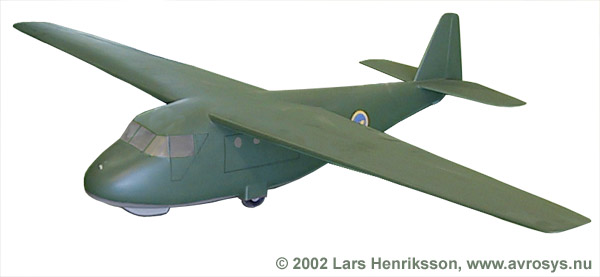|
|
||
| Lg 105 - AB Flygindustri Fi-3 (1944-1945) | ||
| Page 1 (1) | ||
|
|
||
 |
||
|
Large
transport glider aircraft were built during WWII primarily by the UK,
the USA and Germany. The early German DFS 230 could only carry eight
soldiers, but played and important role in the first years of the war.
DFS 230 was followed by the larger Gotha Go 242, which could load 21
soldiers or a few small motor vehicles. The Messerschmitt Me 321 Gigant,
designed to take as heavy loads as tanks, was the largest glider ever
built. It had a wing span of about 55 metres and a length of early 30
meters, but landed on simple skids. To take off, it needed a droppable
trolley weighing eight tons. More than 100 Gigants were built, but their
unreal size made them almost useless. Only a few of them got into
action.
The
famous British Airspeed Horsa could load 25 soldiers or two Jeeps.
Nearly 4.000 Horsas were built. Another successful British cargo glider
was the General Aircraft Hamilcar. But the glider aircraft built in
largest number was the Waco CG-4 Haig - Hadrian in the RAF. Almost
14.000 were built. The gliders of the Allied Forces played an important
role at the D-day.
Therefore,
it was natural for the Swedish defence to investigate the usefulness of
Swedish transport gliders. In the beginning, a fleet of 70 gliders were
considered. AB
Flygindustri at Halmstad, manufacturer of sailplanes, got the commission
to design a glider - Fi-2 - with a capacity of six persons. But this
project was cancelled. Instead a larger glider - Fi-3 - was designed by
the company. This aircraft could carry a crew of two and ten soldiers. A
glider aircraft for evaluation was ordered and delivered in February,
1944. It got the Air Force designation
Lg 105 (and the Sw/AF No 105001). The
front part of the fuselage was of welded steel tube with a baked plywood
shell cover. The rear part was of monocoque plywood construction.
Control surfaces and the rear part of the wing had fabric covering. The
cargo doors were folding upwards. Trials
began immediately after the glider was delivered. A B 5 dive-bomber was
used as tug. At a routine test flight in April, the glider broke up in
the air. The accident was caused of broken screws where the wing spar
was fixed to the fuselage.
After
all, five new Lg 105’s were ordered by the Air Force. Three gliders
were built by AB Flygindustri, but further tests showed that the design
was too weak structurally. The whole project was cancelled in September
1945. To fulfill the demand for transport capacity, the Air Force
modified a number of the old B 3 (Ju 86) bomber as transport aircraft.
As
a preparation for the glider project, about 30 B 5’s were fitted with
hooks for towing by SAAB at Trollhättan. A project group plans to build a flying replica of a Lg 105. Photo:
Model, exhibited at Flygvapenmuseum. Length: 9,70 m. Span: 16,50 m. MTOW: 2.100 kg. Max. speed: 250 km/h. Lift/drag ratio 15:1.
|
||
|
|
||
|
|
||
|
|
||
|
© Lars Henriksson |
|
Updated 2010-07-11 |